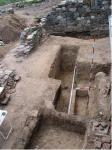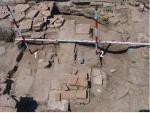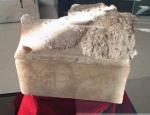Summary (English)
ST. JOHN PRODROMOS MONASTERY (Kazimir Popkonstantinov, Tsonya Drazheva, Rossina Kostova – korina68bg@yahoo.com) The apse of an earlier church was discovered in the Presbytery of the basilica. The floor of the earlier church, which was burned, was documented in the western part of the central nave of the basilica and fragmentary frescoes were found. The foundations of the earlier church were also discovered in the Prothesis and the Diaconicon. Unlike the basilica which had three apses, the earlier church was single-apsed. A rectangular cassette constructed of bricks bonded with mortar, 30 cm by 20 cm in size, was discovered under the floor in the Presbytery of the basilica. The cassette contained a marble reliquary with the shape of a small sarcophagus, 20.5 cm long, 12.5 cm wide and 14.5 cm high, with a lid in the shape of a ridge-roof with four acroteria in its corners. The reliquary dated to the 5th – 6th century AD and contained bone pieces of an adult, probably a man. The primary cassette, which contained the reliquary, was discovered at 20 – 25 cm under the floor of the Presbytery. It measured 30 cm by 24 cm and was constructed of bricks bonded with mortar. A small stone box, 4 cm in width, 6 cm in length and 3.5 cm in height, with a Greek inscription of the 5th – 6th century AD was found nearby. The inscription mentioned Thomas who is praying to God to help him, the name of St. John in genitive case and the date of 24th June. Thomas was probably a Byzantine monk who brought to the monastery pieces from the holy relics of St. John the Baptist placed inside the stone box, while the 24th June was the birthday of the saint. Fragmentary frescoes were found nearby. Two monastery wings of parallel rooms arranged in lines were discovered in the northeastern and the eastern parts of the yard, adjacent to the fence wall. The wings existed from the middle of the 14th to the middle of the 17th century when the monastery was destroyed. A metallurgical workshop was documented in the northwestern monastery building.
- Kazimir Popkonstantinov - Department of Archaeology, Veliko Tarnovo University St. Cyril and St. Methodius
- Tsonya Drazheva - Regional Museum – Burgas
- Rossina Kostova - Department of Archaeology, Veliko Tarnovo University St. Cyril and St. Methodius
Director
Team
Research Body
- Regional Museum – Burgas
- Veliko Tarnovo University St. Cyril and St. Methodius






![Download [PDF]](/excavation/skins/fasti/images/results/download_sml.png)

